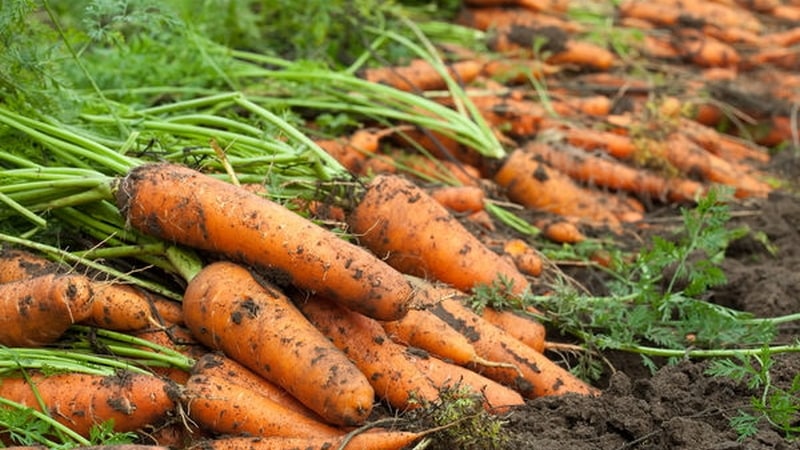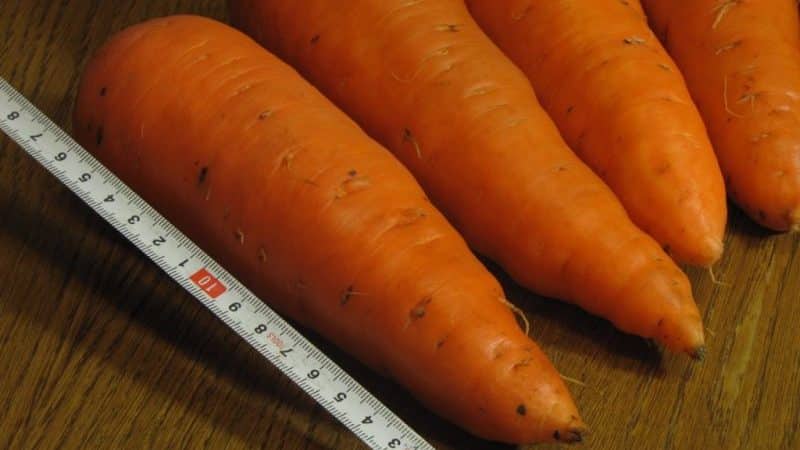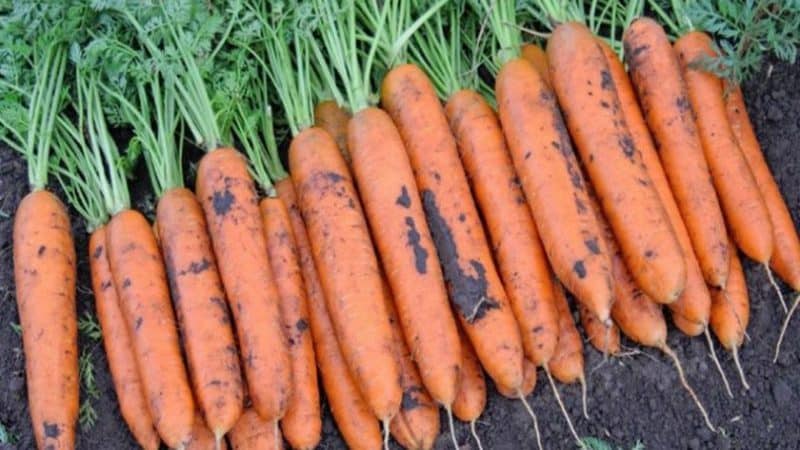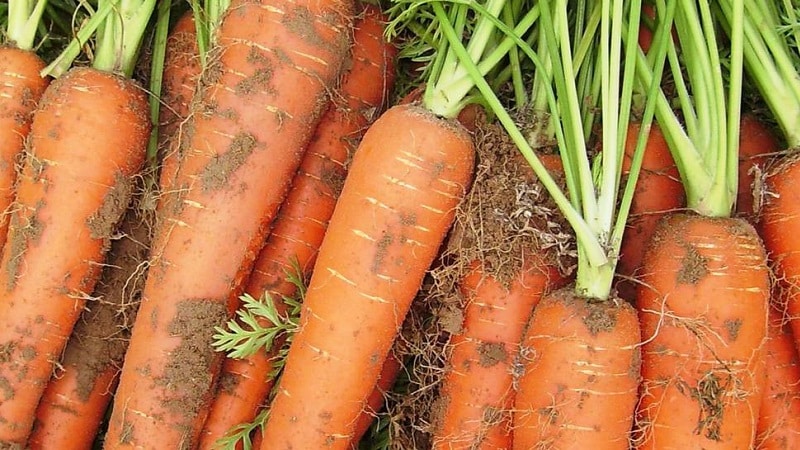Review and description of early varieties of carrots
Carrots are an amazing vitamin-rich vegetable that gives beauty and health to people and not only them. Zoo staff add it to the diet of flamingos - it helps the birds maintain the brightness of their plumage.
The culture is not demanding on heat. Sowing early varieties of carrots in the spring allows you to harvest a harvest of vitamin-rich root crops in less than two months. How to choose an early variety? We will talk about this in the article.
Advantages of early varieties
Depending on the ripening period, carrot varieties and hybrids are divided into three subspecies:
- early ripening – ripening period 50-60 days;
- mid-season – 90-120 days;
- late ripening - 125 days or more.
The main advantage of early varieties of the crop is the rapid harvest. Early carrots are a source of vitamins: they are used to prepare salads, side dishes, and soups.
Need to know. Early varieties of carrots are not large in size, and therefore their yield is low. In addition, such root vegetables are poorly stored.
Early root crops are also grown for sale. At the beginning of summer, such vegetables are in high demand on the market.
Carrot seeds in stores are represented by domestic and foreign (mainly Dutch) varieties. When choosing a variety, keep in mind that Dutch breeders work primarily to improve the appearance of root crops, rather than their taste.
Carrots of Russian selection contain more carotene and have a sweet taste. In addition, it is better adapted to our weather conditions.

Early varieties of carrots for the middle zone
Obtaining a stable harvest of any vegetables is impossible without taking into account weather conditions. When choosing seed material for cultivation in the middle zone, attention is paid to the speed of ripening of root crops and resistance to temperature changes.
Important! Carrots are resistant to temperature changes in air and soil, but are demanding of nutrients and soil moisture.
Here is a description of popular early ripening varieties and hybrids for the middle zone.
Parisian Carotel
The carrot is round in shape, sweet, weighing from 30 to 50 g. The plant is resistant to flowering and diseases. It is poorly stored, like all early ripening varieties.
Amsterdam
Product of Dutch selection. The weight of root crops is from 50 to 150 g. The variety is distinguished by its sweet taste and resistance to cracking of root crops.
Artek
Weight from 70 to 130 g. Tasty, sweet. Resistant to white rot and unpretentious to soil composition.
Rex
The variety is distinguished by large root vegetables - from 180 to 210 g. Carrots are juicy and tasty. Productivity is high due to the large mass.
Hybrid Buror F1
Bred by French breeders. Small root vegetables weighing from 60 to 120 g with a small core. Excellent taste and high yield (from 2 to 6 kg per sq. m).
Hybrid Parmex F1
Small spherical root vegetables weighing from 30 to 50 g. Pleasant, sweet taste. Suitable for whole canning.

Early varieties for the Urals
The short and often cool Ural summer does not allow late varieties of the crop to ripen in open ground. Therefore, preference is given to early and mid-ripening varieties.
Let's list the popular early varieties and hybrids suitable for cultivation in the Urals and in Siberia.
Hybrid Victoria F1
Root crops ripen in 70-80 days. The shape is not too elongated, no more than 20 cm, with a rounded tip. The core is thin, the flesh has a reddish tint. The hybrid is suitable for canning and fresh consumption.
Hybrid Colorit F1
The carrots of this hybrid have a sweet taste; children eat them with pleasure. The root vegetables are medium-sized, weighing 200 g, with smooth skin.
Nastena
Ripens in 80-90 days. The roots are smooth, with smooth skin. The shape is elongated, the end is rounded. Average weight – 150 g. Productivity per 1 m² – about 6.5 kg.
Alenka
Ripens in 70-80 days. Bunch products are removed from the garden after 50 days. The root vegetables are medium-sized, smooth, up to 12 cm long. The pulp is crisp and sweet.
Belgien White
A distinctive feature of this variety is the white color of the roots. After heat treatment, a special aroma appears, which is why these carrots are often used for preparing hot dishes.
For the North-West

For cultivation in the regions of the North-West (Leningrad, Novgorod region, etc.), zoned varieties of domestic and foreign producers are chosen. Since the warm summer period here averages three months, when choosing carrots, preference is also given to early or mid-ripening varieties and hybrids.
Children's taste
Ripens in 75-80 days. Children eat sweet and juicy carrots with pleasure. Length up to 15 cm, conical shape. The variety is resistant to cold weather. They begin to sow seeds in April.
First collection
Ripening time is 90-100 days. A distinctive feature is the high content of sugar and carotene. The shape of the root crops is conical, with a pointed end. The carrots are juicy and tender.
Lenochka
Ripens in 80-85 days. Root vegetables are cylindrical in shape, up to 16 cm long. Weight up to 150 g.The core is thin. Productivity is on average 5 kg per 1 m².
Granddaughter
Carrots ripen in 80-90 days. A distinctive feature is the round shape of the vegetable. Sweet and juicy bright orange carrots are a favorite among children. The diameter of the root crop is 3-5 cm, weight no more than 50 g.
Hybrid Mother-in-law F1
Ripening time is 80-90 days. It has a delicate, sweet taste. The length of the root crop is up to 11 cm, weight is about 200 g. A distinctive feature of the hybrid is its high yield (up to 10 kg/m2).
Features of planting and growing early varieties of carrots
Carrots are unpretentious crops that do not require special care. However, the process of growing early-ripening carrots has its own characteristics.
Planting dates and site selection
The vegetable is not as demanding on heat as many other root vegetables. Carrot seeds germinate already at a soil temperature of +3-4˚C, so early varieties begin to be sown already in April.
Important! Young carrot sprouts can easily tolerate light frosts.
For sowing early varieties, choose sunny areas protected from the wind. Carrots grow better on light and fertile soil, although they show good yield in heavy soil.
Preparing and sowing seeds
The purpose of pre-sowing seed preparation is to reject non-germinating specimens and accelerate the emergence of sprouts.
The preparation and sowing procedure consists of several stages:
- The seeds are soaked in warm water for 10 minutes, all floating seeds are removed.
- Selected seeds laid out on a damp cloth and kept in a warm place for several days. The sprouted seeds are ready for planting.
- On the prepared bed, mark grooves 2-3 cm deep and water them with warm water. A distance of at least 15 cm is maintained between adjacent grooves.
- Seeds are placed at the bottom of the grooves and sprinkled with damp soil.
Care

Caring for carrot beds involves weeding, thinning the crops and loosening the soil. Timely removal of weeds is especially important at the initial stage of plant growth.
Simultaneously with the removal of weeds, the soil is loosened. Compaction of the top layer and the formation of a crust leads to curvature of the root crops.
In order for the root crops to grow large, the crops are thinned. The first thinning is carried out after the first true leaves grow. A distance of 2-3 cm is left between neighboring plants. Subsequently, thinning is repeated, increasing the distance between the bushes to 5-6 cm.
Fertilizing and watering regime
Early carrots grow quickly - the harvest is harvested within 50-60 days after the sprouts appear. Therefore, in the process of growth there is enough feed it once, 3-4 weeks after germination.
Fertilizers are applied in liquid form. Dissolve 1 tbsp in a bucket of water. l. “Nitrofoski”, 2 cups of wood ash, 1 tbsp. l. potassium nitrate and 0.5 tbsp. l. urea and double superphosphate.
When growing carrots, special attention is paid to watering. Lack of moisture leads to accumulation of bitterness in carrots. Soil moisture is equally important at all stages of growth.
Carrot beds are watered infrequently, but abundantly. For irrigation use warm, settled water. The depth of soil moisture corresponds to the size of the root crop: the larger the carrots, the more water needs to be poured onto the bed.
Pests and diseases
The main pest of carrots is the carrot fly.. The pest emerges from the soil in spring, when the earth warms up to 16-18°C. The female fly lays eggs on the root collar of the plant, and the larvae that emerge from the eggs eat the roots, leaving tunnels in them.
Damaged plants are recognized by the purple-red color of the tops. Gradually the leaves turn yellow, wither, and then dry out. The root crop, eaten away by larvae, becomes covered with reddish-brown tubercles.
Prevention of carrot fly infection involves maintaining crop rotation, loosening the soil and removing weeds, and mulching crops with peat chips.
Advice. Plant onions and garlic around the perimeter of the carrot bed. Their aroma repels carrot pests.
If the fly does appear, spraying with infusions of onions and garlic, marigolds, and tomato tops will help in the fight against it. Among the chemicals used are Intavir and Actellik.
Among the diseases, carrots are affected by rot (white, felt, dry, black), brown spot, and powdery mildew. The development of diseases is caused by violation of the irrigation regime (excessive soil moisture), thickening of crops, and non-compliance with crop rotation.
Treating crops with a 1% solution of Bordeaux mixture at the rate of 0.6-0.8 liters per 1 m² helps reduce the risk of developing diseases.
Harvest and storage

The growing season of ultra-early and early varieties ranges from 60 to 90 days. However, to obtain bunched products, root crops are harvested after 50 days.
Bunch production is the first, earliest harvest of carrots. It is harvested from mid-June, when the diameter of the root crops reaches 1-1.5 cm. The vegetables are not yet fully ripe at this time, but already contain many vitamins and nutrients.
All early ripening varieties and hybrids of carrots are not stored fresh for long. The collected root vegetables can be stored in the refrigerator for several days, after placing them in plastic bags. Also, early harvest can be frozen.
Conclusion
Early ripening carrots are a valuable source of vitamins in early summer. Crispy and juicy root vegetables are enjoyed by children and adults. The general disadvantage of early varieties and hybrids is a short shelf life, low yields and a less rich taste than mid-season and late varieties.